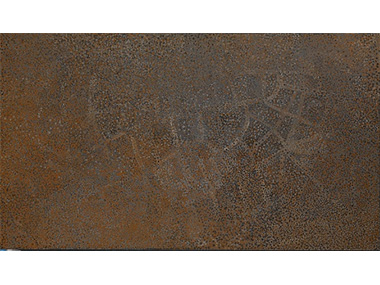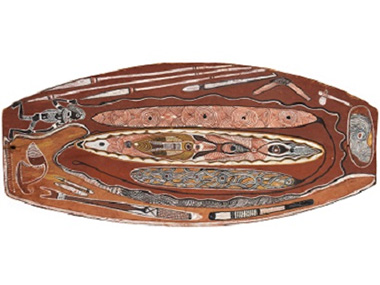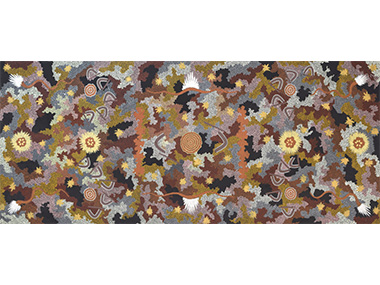The Auction Time of Year

'Untitled' (as all Emily's works were when created) 1990, on offer at Sotheby's in New York with a price estimate of US$250/350,000. 212 x 123cms
Posted by Jeremy Eccles | 28.11.19
Dates:
29.11.19
: 13.12.19
“Toward the end of 1991, women’s Awelye ceremonies were being held in Utopia. December was overwhelmingly humid with hot northerly winds. The anticipation of rain and the ongoing ceremonial activity enlivened the spiritual atmosphere. A number of exceptional paintings (by Emily Kngwarreye) including this particular work - 'Kame-Summer Awelye' (1992) - were produced between November 1991 and February 1992. Emily’s work became more expressionist, with the graphic under-layer of linear (yam-root) tracings and animal prints no longer evident. In this painting, radiant fields of yellow and pink dots which cluster and trace across the surface vary in hue and density. They celebrate the successful life cycle of kame, the finger yam, with its daisy-like flowers which form seeds for making damper”.
I'm grateful to Adrian Newstead of Cooee Gallery for this explanation, which appears in his Marketplace auction catalogue for its dedicated Aboriginal art sale next Tuesday evening in Sydney. After 11 months in which there have been no such dedicated auctions, we suddenly have two of them – the other being Tim Klingender's Sotheby's auction in New York, for the first time on Friday 13th December. And he too has an Emily Kngwarreye 'Summer Celebration' (1991) painting – a larger one than Cooee's, and, appropriately, priced higher: US$3/400,000 for three metres as against A$2/250,000 for two.
They're both beauties from a period that I have no doubt was the highest point of Emily's dotted life. The big dump-dumps followed, but by 1993, she seems to have lost control of her sensational colour sense during the year or so that perennial Kngwarreye curator, Margo Neale justifies as her 'Colourist' period. Balderdash – and both auctions go along with my judgement by suggesting much lower prices for works that they're auctioning from that time. It's only when Sotheby's offers a dense black and white yam work from 1995 that the price lifts again.
The 'Summer Celebrations' are therefore, for me, the high point of both sales. But there's plenty of interest elsewhere.
At Cooee, for instance, there are lovely entry-level works by Daniel Walbidi, Bill Whiskey, Djambawa Marawili, Mick Namarari, Minnie Pwerle, Maggie Watson and even Rover Thomas. At the higher end, there's a pricey 'Wandjina' by Alec Mingelmanganu and a significant Clifford Possum with a wonderful back story involving the Queen. Both John Mawurndjul and Nyurapaya Nampijinpa have significant works up for sale. And there's the total oddity of a Dennis Nona ceramic work created when he was still a student in Cairns.
My favourites, though, would be a Paddy Jaminji dance board from Warrmun and a Charlie Brinkin bark from Port Keats in about 1950 that seems to presage the ceremonial images that wouldn't be unleashed again until the men at Papunya got going 20 years later.
Whether Tim Klingender has the sale he dreamt of when he persuaded Sotheby's that the US rather than London was where the money was for Aboriginal art currently, I'm not sure. He originally announced a date in November when major contemporary art sales were happening in New York. Now he's associating with Rare Wines and Fine Jewels, Important Watches, Tiffany and Marc Jacobs Designs. Champagne and a talk by Henry Skerritt from the Kluge/Ruhe Museum two days before the sale may concentrate the market's mind though.
Interestingly, Klingender has laid out his sale in an acommercial, historical way, starting with a densely populated 1962 bark, 'Seagull' from the Yolngu Big Man Mawalan Marika. Who'da thought that barks might whet the appetite in New York? Could this be related to the projected 'Madayin' tour of 80 years of bark-making from Yirrkala in 2021? And who'da thought that the humble seagull was a mortuary symbol for them?
The sale then progresses through early boards from Papunya – Uta Uta Jangala's 'Untitled' (1971) with “daring” blue and red semi-circles representing marks in the sand by seated ceremonial men is said to have been amongst the first twelve to be sold. However Johnny Warangkula's 'Dingo Camp at Wulungurru' (1973) is a huge advance aethestically, richly detailed and fascinating for the suggestion that 'dogging' was used as an excuse by families to escape the confines of the mission and put their kids through initiation.
On to Yuendumu, the next community to take up painting, and quite soon a fabulous early Emily, 'Untitled' 1990 which still bears the traces of that “under-layer of linear (yam-root) tracings and animal prints“ which gave the first year or so of her career a more 'rooted' (if you'll excuse the pun) flavour. And suddenly we hit a Gordon Bennett – the pioneering urban Aboriginal artist from Brisbane. Amazingly, his 1990 work 'Self Portrait (But I always wanted to be one of the good guys)' has the top price estimate in the show at US$350/450,000. Referencing Colin McCahon's immortal 'I Am' script via Imants Tillers, Klingender justifies his pricing thus: “It is arguably his most important work, having just won the Moet & Chandon Fellowship, and (it) featured in several major exhibitions in Asia, Europe, the UK and Australia, and (was) published in dozens of contemporary art publications”.
Klingender also enthuses over his inclusion of an early Richard Bell work, 'Pigeon Holed' (1992) – who knew he's been around so long? - first seen in that year's Sydney Biennale. Not only has he had international prominence through his antics at this year's Venice Biennale but, Klingender reminds me, “He has been commissioned to take over the Tate Modern's Turbine Hall in 2021 (in London), and his work has been exhibited widely in the USA”.
There follow solid works by Ronnie Tjampitjinpa, Turkey Tolson (a classic 'Straightening Spears') and, my favourite, Joseph Jurra whose op-art black and white (with occasional flecks of red) 'Travels of the Tingari Men......' (2001) makes my computer screen shiver and shake. Oddly he's priced (at US$50/80,000) on a par with Mr Hot in the US, Warlimpirrgna Tjapaltjarri for a 2012 work that pulsatingly evokes the incised patterns on the pearl shell pubic cover that he'd have worn in the desert as a serious maparn/healer.
The Sotheby's sale ends with 'Yunpalara' (2005), offering all the colour and vigour from a Kayili Artists collaborative that many feel the Papunya Tula artists have lost as they master technique. The vigour comes from the fury of the Perentie Lizard (the Ngintaka) who is in pursuit of the emu who's been teasing him!
So, some marvellous works in both auction sales – which is more than can be said for the 300 odds and sods that the Laverty Collection sold at Shapiro at the end of October. These were works, one suspects, bought out of kindness to artists and art centres that had high hopes of the legendary Laverty munificence. Still, prices for the Aboriginal art were lower than they should have been, I fear – a fine Hector Jandany for $5000 and an unsold Lorna Fencer at $2500! Perhaps some of the truly ordinary prints and glassworks deserved their fate! Non-Indigenous Ildiko Kovaks – often inspired by the same landscape as the Aboriginal artists – hit the top price at $55,200.
Tim Klingender's Sotheby's auction in New York
Cooee's auction in Sydney
Share this:
»  del.icio.us
»
del.icio.us
»  Digg it
»
Digg it
»  reddit
»
reddit
»  Google
»
Google
»  StumbleUpon
»
StumbleUpon
»  Technorati
»
Technorati
»  Facebook
Facebook
Contact Details

Charlie Brinkin 'Men's Ceremony' (c.1950) natural earth pigments on stringy bark 66 x 30 cms (irregular) EST. $1,500 - $2,500

Clifford Possum Tjapaltjarri 'Untitled (Ceremony at Mount Allan)' 1989/1990 synthetic polymer paint on Belgian linen 296 x 128 cms EST. $70,000 - $90,000
Further Research
Artists: Emily Kngwarreye | Alec Mingelmanganu | Bill Whiskey | Charlie Brinkin | Charlie Brinkin | Clifford Possum Tjapaltjarri | Daniel Walbidi | Dennis Nona | Djambawa Marawili | Gordon Bennett | Hector Jandany | John Mawurndjul | Johnny Warangkula | Joseph Jurra | Lorna Fencer | Maggie Watson | Mawalan Marika | Mick Namarari | Minnie Pwerle | Nyurapaya Nampijinpa | Paddy Jaminji | Richard Bell | Ronnie Tjampitjinpa | Rover Thomas | Turkey Tolson | Uta Uta Jangala | Warlimpirrgna Tjapaltjarri
News Tags: Adrian Newstead | Cooee Marketplace | Jeremy Eccles | Laverty Collection | Shapiro | Sotheby's | Tim Klingender
News Categories: Auction | Australia | Blog | Event | Exhibition | Feature | Industry | News | North America
Exhibition Archive
- 26.03.20 | Out on Country!
- 19.03.20 | BIENNALE OF SYDNEY 2020
- 13.03.20 | LAURIE NILSEN
- 03.03.20 | EMILY v CLIFFORD
- 02.03.20 | The Ephemeral and the Ineradicable
- 25.02.20 | WADJUK IN THE BLACK
- 17.12.19 | Sotheby's NY Inaugural Aboriginal Art Auction
- 11.12.19 | Festivals in the Blak
- 11.12.19 | Cairns Airport Commission
- 09.12.19 | KNOWLEDGE GROUND
- 30.11.19 | Linear?
- 28.11.19 | The Auction Time of Year
- 25.10.19 | It's Time for Tarnanthi
- 02.10.19 | FIBRE ALCHEMY
- 17.09.19 | Fondation Opale Glows Opalescent
Advertising

